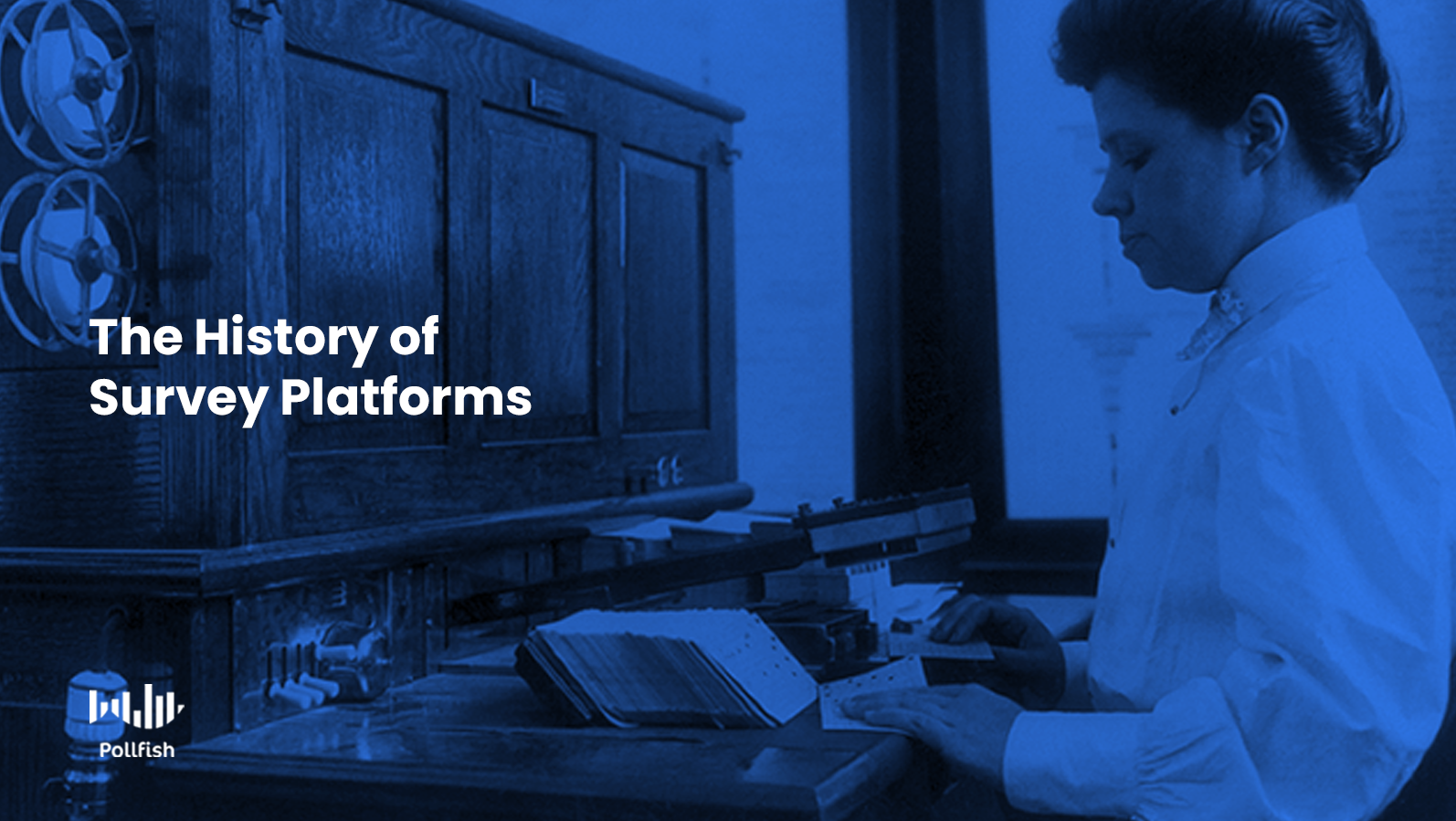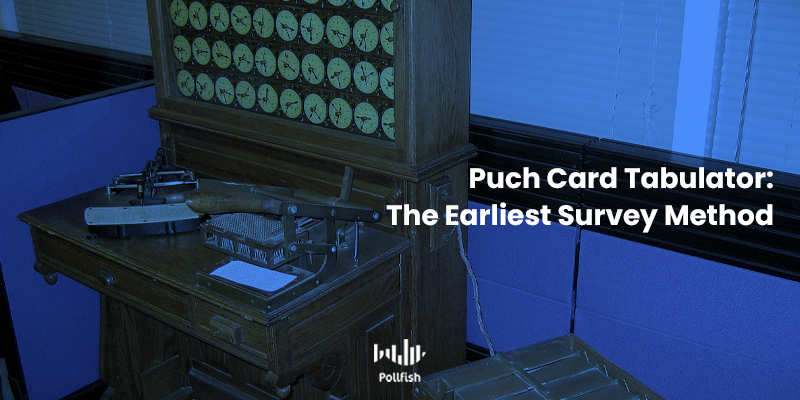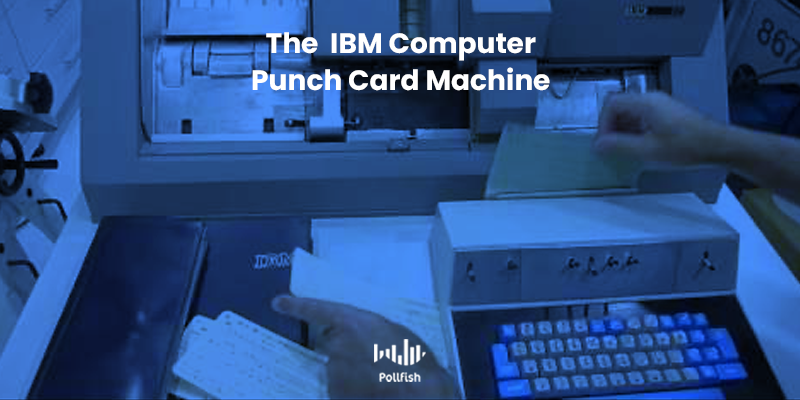The History of Survey Platforms & Technology

In the time since the first survey was conducted, surveys have evolved to become one of the most common methods of researching groups of people. Survey platforms have further revolutionized the way we collect and analyze data, making it easier for researchers to identify trends and draw conclusions more quickly and accurately.
Interestingly, the need to conduct surveys and manage the resulting data was one of the driving factors in the development of early computing technology. While survey platforms are a relatively recent concept, the development of computing technology to support survey data has been around much longer.
This article presents the history of survey platforms to show just how online survey tools have morphed into the market-research powerhouses of the digital age.
Well-Known Early Surveys
Surveys have not always been a standard component of research, in fact, they have been in use for less than 200 years. The earliest known survey was conducted in 1834, by the Statistical Society of London. It was a simple, door-to-door survey that sought to understand the occupations of people living in Manchester, England.
The American Community Survey (aka, the US Census), conducted every 10 years, is likely the most well-known American public survey. This massive undertaking seeks to obtain demographic data about every household in the United States via a survey. The manner in which it has been conducted has changed dramatically since its conception in 1790.
During the very first census, the count was performed via a physical visit to every household in the United States, but this gave way to phone, mail, and eventually online data collection.
Nielsen ratings are another example of prominent public surveys. Conducted every year since 1947, this survey collects information about how Americans of various demographics consume media. Media outlets, businesses and marketers rely upon these surveys to make decisions about how to evolve their products, choose the proper media advertising channel and run effective marketing campaigns.
You may wonder how these massive amounts of data were collected and analyzed before the existence of computers. Interestingly, it was the need to collect and organize exactly this type of data that led to the development of computing power.
The Punched Card Tabulator

The development of the punched card tabulator marked the first major breakthrough in the way we collect survey data. In the late 1800s, the United States experienced unprecedented population growth, due to the large number of immigrants migrating to the country. When it came time to conduct the 1890 census, government officials noted that it would take over 8 years to count the resulting data from the census.
An enterprising young engineer of the time, Herman Hollerith proposed a solution. He designed a system whereby a paper card with a series of punched holes would represent each individual’s census information. While the collection of this data was manual, the processing of the information could now be automated.
Thanks to Hollerith’s creation, the census count took just two years and saved the US government $5 million. Hollerith turned his machine into a business, which he named the Tabulating Machine Company.
His machine soon became commonplace in the back offices of a wide variety of industries throughout the world, including railroads, oil companies, drug manufacturers, utility companies, and large department stores.
His machine was later sold to the Computing-Tabulating-Recording company (C-T-R), which evolved into IBM in the 1920s. His design transformed data processing in nearly every industry in the world and paved the way for the development of the computing giant, IBM.
Punched Card Statistical Analysis & the Rise of IBM

The creation and subsequent development of IBM into a computing super-giant had its very roots in survey data collection.
In 1928, IBM introduced an evolution of Hollerith’s punched card tabulator and named it the “IBM Computer Card,” which was commonly referred to as the IBM card. Remarkably, this seemingly simple invention was one of IBM’s most important technological advances and was responsible for the rise of IBM as the data processing giant in the early 1900s.
Today, with the proliferation of data and computing systems, it seems hard to believe that IBM’s cards held nearly all of the world’s data for almost half a century. Not only did the cards advance data processing, but they created a steady profit stream that allowed IBM to develop into the company it is today.
The IBM card allowed customers to store a large amount of data, thanks to its 80-column format and character codes. The challenge then was to develop a system that could make sense of the huge amounts of data that were stored on these cards. The device used to process this information was known as a tabulator.
During World War II, IBM developed the earliest type of supercomputers in order to process data that was stored on these cards. While these computers looked and acted nothing like computers today, the concepts used to convert and process data stored on physical cards into a digital format set the foundation for the later development of modern computers.
Computer-Assisted Survey Information Collection (CASIC)
From the 1950s, the use of computers to assist in the collection and analysis of survey data became more frequent. The use of computers in any aspect of survey creation, distribution, or analysis, is referred to as computer-assisted survey information collection (CASIC).
CASIC made it easier and faster to compile, store, and analyze data, which increased both the popularity and reliability of surveys. Computers helped lower the cost of survey research, reduced errors during data entry, and improved data quality by eliminating interviewer bias.
Before the existence of the Internet, computers were utilized in various ways to support survey research.
Applications of the CASIC
Here are some of the many ways that computers were used to collect survey data:
- During phone or in-person interviews, the interviewer reads from a computerized questionnaire and enters the respondent’s answers.
- An individual sits at a portable computer to read and answer survey questions.
- Surveys are distributed to respondents via a floppy or optical disk, which is returned by mail.
- Touch-tone data entry (TDE) allows the respondents to answer questions by phone by pressing numeric keys.
- Respondents answer questions by phone, which are then recorded and automatically transcribed into text.
In each of these modes of collecting survey data, the information is digitized, making it easier to store, analyze, and update the data with subsequent survey iterations.
The Development of Online Survey Platforms
While surveys have been in existence for nearly 200 years, the relatively recent development of online survey platforms marked the most dramatic evolution in how surveys are conducted and analyzed. The ability to oversee the entire lifecycle of a survey from a computer represented a fundamental change in the world of market research.
Before the advent of online survey platforms, the process of creating a survey, distributing it, and then analyzing survey data was a cumbersome and time-consuming process, even with CASIC technology. With the development of online surveys, survey research has become a critical tool for a wider range of research fields, such as marketing, social studies, and official statistics.
Online survey research offers distinct advantages in comparison to pre-Internet CASIC methods. These include:
- More cost-effective
- Easier to design and develop
- Faster data collection and processing
- Option to include advanced skip logic
- Ability to provide inline support to respondents as needed
- Ability to respond to the survey on any device
Online Surveys for Businesses, Banks Government Entities & More
Today it is hard to fathom how surveys were conducted before online methods were available. It required a staggering amount of manpower and determination to collect data from populations and then make sense of that data.
Thanks to online survey platforms, surveys are widely used to collect information about any number of topics. Whether they contain one question or hundreds, surveys have become commonplace in our study of the world around us.
Surveys can be deployed in a matter of minutes, giving businesses an easy way to understand their customers in order to improve their products, services, and interactions.
Frequently asked questions
How did the punched card tabulator advance the process of survey data collection?
The punched card tabulator made it possible to automate the process of counting survey results. This greatly reduced the amount of time and manpower required to compile survey data.
Who developed the punched card tabulator?
Herman Hollerith developed the punched card tabulator, which was later sold to the Computer-Tabulating-Recording company.
What was the IBM Computer Card?
Also known as the IBM card, the IBM Computer Card was a standardized card format that was used to store data via character codes in an 80-column format.
What is Computer-Assisted Survey Information Collection (CASIC)?
Computer-Assisted Survey Information Collection (CASIC) refers to any use of computers to help in the collection and/or analysis of survey data.
What is an online survey platform?
An online survey platform is a tool that allows surveys to be created, distributed, and analyzed from a centralized, remotely-accessed, digital platform.
Pollfish Marketing Team
Ready to Try Pollfish?
Create your survey with AI, target high-quality respondents starting at $0.95 per complete, and start getting results in just minutes in real-time. From running a simple product concept survey to managing a constant stream of trackers for dozens of clients in dozens of countries, we’ve got you.
